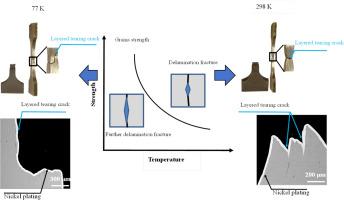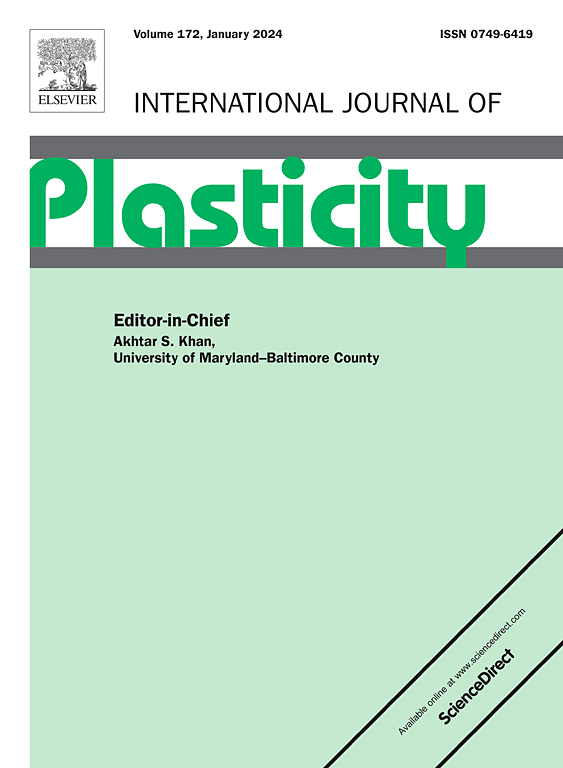具有片状晶粒的 BCC 结构 CLAM 钢在 77 开尔文条件下的优异拉伸延展性和强度
IF 9.4
1区 材料科学
Q1 ENGINEERING, MECHANICAL
引用次数: 0
摘要
体心立方(BCC)金属和合金的低温拉伸脆性会严重影响其应用。在这项研究中,我们通过调节轧制和热处理工艺制备了具有片状晶粒的体心立方结构中国低活化马氏体钢(CLAM),成功扭转了钢的延展性随温度降低而下降的趋势。与目前的面心立方(FCC)结构钢和高熵合金相比,片状晶粒 CLAM 钢在 77K 温度下具有出色的强度和延展性协同作用,而且原材料成本更低。片状晶粒钢优异的低温延展性可归因于低温下晶粒强度的增加,这促进了层状撕裂裂纹的扩展;这反过来又导致钢的缩颈面积显著增加,从而弥补了延展性的下降。我们的结论是,我们的片状晶粒结构可用于显著增强 BCC 金属和合金的低温拉伸延展性,从而将其使用范围扩大到低温。本文章由计算机程序翻译,如有差异,请以英文原文为准。


Exceptional tensile ductility and strength of a BCC structure CLAM steel with lamellar grains at 77 kelvin
The low-temperature tensile brittleness of body-centered cubic (BCC) metals and alloys can seriously compromise their service applications. In this study, we prepared a BCC structured China low activation martensitic steel (CLAM) steel with lamellar grains by regulating the rolling and heat-treatment processes, successfully reversing the decreasing trend of ductility in the steel with decrease in temperature. Compared with current face-centered cubic (FCC) structural steels and high-entropy alloys, the lamellar grained CLAM steel exhibits an excellent synergy of strength and ductility at 77K, but with lower raw material costs. The superior low temperature ductility of the lamellar grained steel can be attributed to an increase in grain strength at low temperatures which promotes the propagation of layered tearing cracks; this in turn leads to a significant increase in the necking area of the steel, thereby compensating for the decrease in ductility. We conclude that our lamellar grain structures can be utilized to significantly enhance the low-temperature tensile ductility of BCC metals and alloys, thereby expanding their service range to cryogenic temperatures.
求助全文
通过发布文献求助,成功后即可免费获取论文全文。
去求助
来源期刊

International Journal of Plasticity
工程技术-材料科学:综合
CiteScore
15.30
自引率
26.50%
发文量
256
审稿时长
46 days
期刊介绍:
International Journal of Plasticity aims to present original research encompassing all facets of plastic deformation, damage, and fracture behavior in both isotropic and anisotropic solids. This includes exploring the thermodynamics of plasticity and fracture, continuum theory, and macroscopic as well as microscopic phenomena.
Topics of interest span the plastic behavior of single crystals and polycrystalline metals, ceramics, rocks, soils, composites, nanocrystalline and microelectronics materials, shape memory alloys, ferroelectric ceramics, thin films, and polymers. Additionally, the journal covers plasticity aspects of failure and fracture mechanics. Contributions involving significant experimental, numerical, or theoretical advancements that enhance the understanding of the plastic behavior of solids are particularly valued. Papers addressing the modeling of finite nonlinear elastic deformation, bearing similarities to the modeling of plastic deformation, are also welcomed.
 求助内容:
求助内容: 应助结果提醒方式:
应助结果提醒方式:


